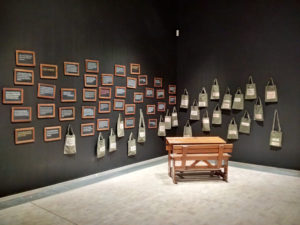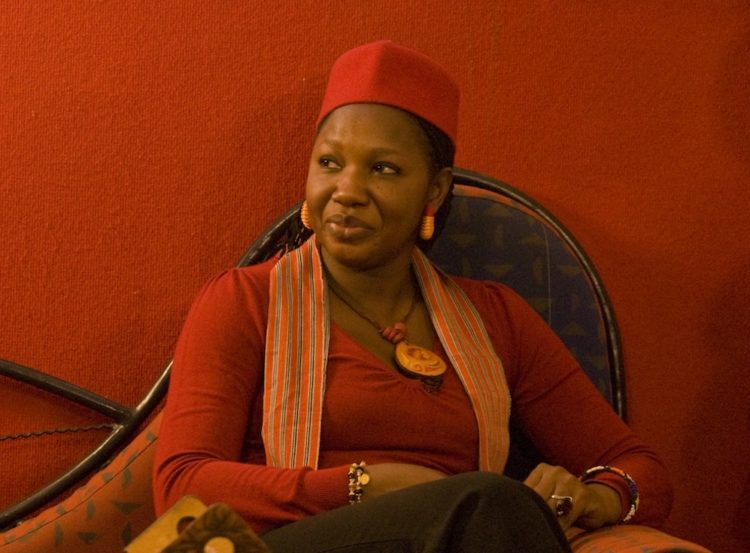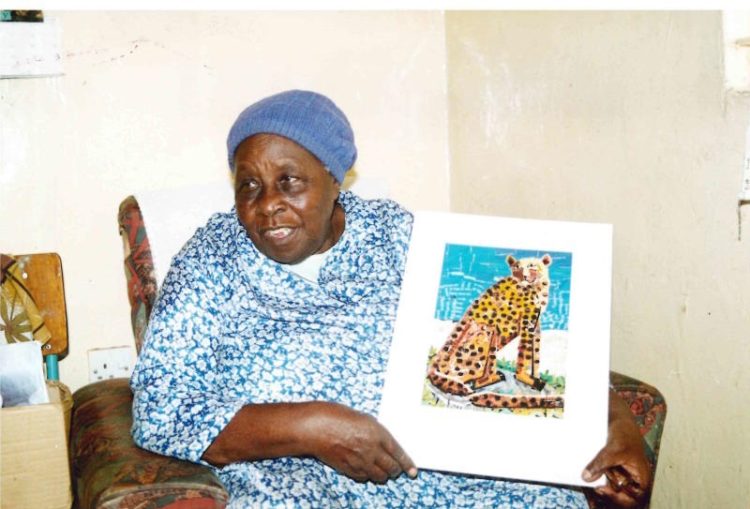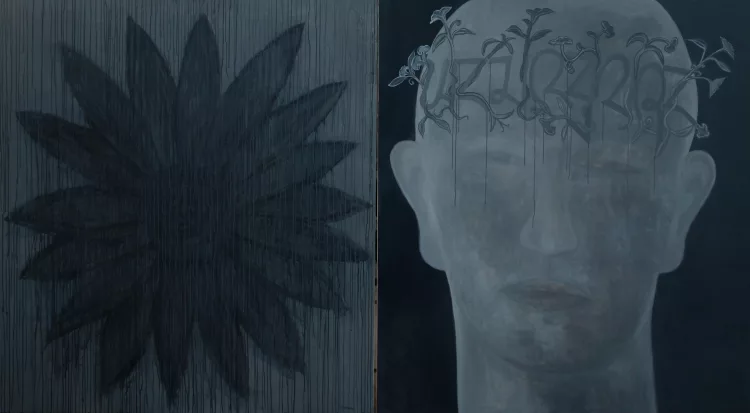Interviews
N’Goné Fall moves forward stealthily, in the shadows more often than in the light. The following conversation gives us insight into her career in visual arts, which is a testament to her unfailing involvement in the promotion of a more equal representation of women.
Élise Atangana: You and Jean Loup Pivin co-authored Anthologie de l’art africain du XXe siècle [Anthology of 20th-century African Art], published by Revue Noire1 in 2001. Why does the publication feature so few women?
N’Goné Fall: The Anthology of 20th-century African Art was an idea we had entertained for a long time, since we had already published an Anthology of African and Indian Ocean Photography in 1998. There was no internet or digital revolution at the time Revue Noire was published. Everything was done analogically, with slides and photographs developed on paper, etc. In our Anthology of African Art, we gathered part of the research and prospecting work we had undertaken over the course of ten years in order to provide an overview that went further back than the 1990s. We wanted to talk about a part of art history that no one knew, at least in international circles. To achieve more clarity, we compiled the various elements linearly, as historians would, retracing history one decade at a time while also rooting the works of the artists in their political and historical context. We then had to identify the artists, track them down through our contacts or by word of mouth. It took us ten years to put together a network in various countries. The Prince Claus Foundation in Holland and the Ford Foundation were our main sponsors.
It’s true that women artists were much less visible in the 90s. And we are completely in the dark when it comes to modern art! I try to fill this void by encouraging academics and young art historians to research the subject. The section that covers the modern period in the Anthology of African Art mostly features South African artists, the reason for this being that the country had accomplished a great deal in terms of art history at the time, therefore granting women a certain degree of recognition. That being said, only very few women were able to gain international visibility in the 1990s.
Only a few names stood out in other countries. Berry Bickle (Zimbabwe)2, Sokari Douglas Camp (United Kingdom and Nigeria)3 and Angèle Etoundi Essamba (Cameroon)4 were among the few women artists present on the continent or on the international scene. Not many women of that generation (born in the 1950s and 1960s) stand out. However, a lot of men began to produce work in the 1970s and 1980s, almost all of whom are featured in the Anthology of African Art.
Most of the time, the women who had studied art didn’t pursue their career, instead returning to the traditional family system. The conditions in place weren’t suited for a woman who wanted to raise a family while also pursuing an artistic career. The commercial dynamic that made the work of artists more prominent, such as fairs, large-scale events, biennales, magazines, and platforms, was less widespread as it is today.

Tiffany Chung, Scratching the Walls of Memory, 2010, installation: 24 hand stitched embroidered sachets made of old army tents, 38 hand made children’s chalkboards with recycled wood, old children’s desk set, 300 x 300 cm, Courtesy Tiffany Chung & Tyler Rollins Fine Art Gallery New York
ÉA: Could you introduce us to some of the artists you featured in the Anthology of African Art and in the magazine?
NF: I took the risk of publishing Otobong Nkanga, who was a student at the time. The work I featured in the Anthology was her graduation project, which wasn’t yet finalised at the time. The work in progress was called Fattening Room (1999). My choice to present the unfinished work of a Paris Fine Arts School student in an anthology didn’t sit well with her teachers. Otobong often visited me at the Revue offices to talk and find moral support. I had already devoted a few pages of the Nigeria issue5 to her work. I’m very happy with the way her career evolved. She already showed a lot of potential.
We published the works of all the women artists we met in each country we visited. In the case of the Benin issue6, I met Edwige Aplogan in Cotonou in 1995. There isn’t a single issue of Revue Noire that doesn’t feature a woman artist. Whether they worked in the field of photography, visual arts, fashion, literature, or cinema made no difference to us. Our priority was quality and relevance.
The 408-page Anthology presents three-thirds of a continent, so we couldn’t possibly include everyone, but it does feature some fifteen women, along with one of their works. The ones we know about nowadays weren’t even artists yet at the time. They were too young.
Our goal was to create a network of art historians, preferably from the continent, in order to give priority to specialists from each country and share our knowledge with a wider audience.

Regina José Galindo, Who can erase the traces?, 2003, performance, video by Damilo Montenegro, 37’28’’, Courtesy Regina José Galindo
ÉA: You also took part in the Global Feminisms exhibition in 2007 at the Brooklyn Museum, New York. What did you take away from the experience?
NF: I wrote a chapter about Africa in the catalogue. Maura Reilly, who was the curator of the Elizabeth A. Sackler Center for Feminist Art at the Brooklyn Museum at the time, was the initiator of the exhibition, which brought together some one hundred artists. She selected a dozen women, mostly curators and a few art historians7, and asked each of them to write a chapter that would recontextualise the exhibited works according to their geographical position. My peers had to work on countries or regions and I, as always, had to write about a 54-country continent…
When the catalogue came out, I received several emails from young researchers, mostly from American universities, asking me for additional information. I had suddenly become the expert on African women artists. I found myself in this strange situation because the text8 I had written was the only one trying to bring together an entire continent by presenting a historical overview of it. The contents of the text became a working base.
ÉA: The National Museum of African Art of the Smithsonian Institution in Washington contacted you to work on a project entirely devoted to women artists. Could you tell us about it?
NF: I try to connect yesterday, today, and tomorrow in everything I do. We all come from somewhere. We are what we are thanks to the generations that came before us and accomplished things or paved the way for us. I also try to create an easier context for the generations to come.
As a matter of fact, where are women in modern African art? I suggested working with the museum to fill this void in our knowledge. It’s an ambitious project that will require establishing partnerships with history departments at universities. We know about today’s young women artists because they are present on the international art scene, but when are we going to pay tribute to the artists who have fallen into oblivion? Let’s take out our searchlights and find them, from country to country and from one neighbourhood to the next.
The museum is thinking about organising an exhibition or publishing a book. My approach was always to see the bigger picture. The museum can show more insight by filling this void where no one seems to be doing so. It’s the only museum devoted to African art from Antiquity to this day. It has the legitimacy to do so, even if only from Washington. The new director will have to decide whether this 100% female programme will see the light of day or not.

Rehema Chachage, The Flower, 2014, video installation, 5’ 36’’, cotton fabric with text by Demere Kitunga, 120 m x 100 m x 500 m, Courtesy Rehema Chachage
ÉA: In your recent exhibition When Things Fall Apart. Critical Voices on the Radars (2016)9, was it a deliberate choice to present more women than men?
NF: The project in Denmark was commissioned. I wasn’t interested in organising an exhibition solely about Africa. I often travel to other regions and meet many artists, both male and female, with whom I would like to work.
Eight of the twelve artists in the show were women, but it was almost a coincidence. I designed three large sections for the exhibition. I wanted to feature artists who are activists at heart, true militants, hence the idea of “critical voices”. Not only were they artists who have created a powerful body of work, but also creators whose output reflects their activism, whether boldly or more inconspicuously, and whatever the cause it defends.
I was relieved by the coincidence; it could’ve gone the other way – four women and twelve male artists. Were it have been the case, I don’t think I would’ve changed the ratio. What mattered to me was to understand who these human beings are. What causes they defend. How their approach resonated with the concepts highlighted by the exhibition. I examined each of the artist’s entire production for the past ten years to make sure I found coherence between their activism and what I consider to be an artistic and conceptual quality.
I already knew I really wanted to work with some of the artists. Regina José Galindo, for instance, whose work is absolutely radical and courageous. She is a Guatemalan performance artist. I met her when I was part of the jury of the Prince Claus Foundation Prizes, one of which she came to receive in Amsterdam. She was very enthusiastic about joining the project. I had also followed the work of Rehema Chachage (b. 1987) for several years, especially during my trips to Tanzania. She studied in South Africa. She, Nidaa Badwan (Palestine), and Wambui Kamiru (Kenya), born respectively in 1982 and 1987, were the youngest artists featured at the exhibition.
I met Tiffany Chung in 2015 in Vietnam. At the time I was also working on a project with Sàn Art, an art centre in Saigon.10 We discussed her personal experience as a boat person. Her approach made sense to me, as did the empathy she showed in her research on migration and exile. All these encounters were the result of a fortunate series of circumstances. In the end, it’s all for the best that the majority of artists featured happened to be women.
N’Goné Fall graduated from the École spéciale d’architecture in Paris. She is a curator, essayist, and cultural engineering consultant. She was the managing editor of the African contemporary art magazine Revue Noire (Paris) from 1994 to 2001. She has supervised the publication of books on visual arts in Africa, including Anthologie de la photographie africaine et de l’océan Indien (Anthology of African and Indian Ocean Photography, 1998), Anthologie de l’art africain du XXe siècle (Anthology of 20th-century African Art, 2001), and Photographes de Kinshasa (Photographers from Kinshasa, 2001), published by Revue Noire, and has curated exhibitions in Africa, Europe, and the United States. She was one of the curators of the Bamako Photography Biennale in 2001 and of the Dakar Biennale in 2002. As a cultural engineering consultant, she is the author of strategic orientation plans, programme studies and performance reports for national and international cultural institutions. Fall was an associate professor at Senghor University in Alexandria, Egypt (department of cultural industries) from 2007 to 2011. She also co-founded the GawLab collective in Dakar, a research and production platform devoted to digital technologies applied to artistic creation. N’Goné Fall is currently completing a book on the history of the Nubuke Foundation.11 Based in Accra, Ghana, the foundation was created in 2006 by Tutu Agyare, Odile Tevie, and the artist Kofi Setordji.
Élise Atangana’s work lies at the intersection between curatorship and exhibition production. Based in Paris, she is interested in the way mobilities, including the movements of people, ideas, objects, and services, affect our everyday lives. Her research focuses on the relationships between physical mobilities and virtual mobilities (movement, representation, practice) and their link to contemporary art: how do the physical and virtual movements of individuals activate space today? How are artistic practices influenced by these new mobilites? How does our relationship to the body interact with the way virtuality modifies our perception of space, and what social and political implications do these modifications imply? Her recent curatorial projects include: Seven Hills, 2nd Kampala Art Biennale 2016, Kampala (Uganda), 3 September-2 October 2016; Entry Prohibited to Foreigners, Havremagasinet Art Centre, Boden (Sweden), 6 June-27 September 2015; co-curatorship of the international exhibition Produire le commun, 11th Dakar Biennale (Senegal), 9 May-8 June 2014; Rencontres Picha – Lubumbashi Biennale (Republic of the Congo), in collaboration with Elvira Dyangani Ose, 1-6 October 2013.
Revue Noire was a French-English bilingual quarterly magazine dedicated to contemporary African art, published from 1991 to 2001 by the Revue Noire publishing house. Revue Noire was founded in 1991 by Jean Loup Pivin, Pascal Martin Saint Leon, Bruno Tilliette, and Simon Njami, whose aim was to publish a high-quality magazine devoted to contemporary artistic expressions in Africa.
2
Revue Noire, March 1998, No. 28, Zimbabwe, Berry Bickle.
3
Revue Noire, September 1991, No. 2, Nigeria, monograph of Sokari Douglas Camp (United Kingdom and Nigeria).
4
Revue Noire, December 1991, No. 3, photographic section devoted to Angèle Etoundi Essamba, who later founded the magazine IAM (Intense Art Magazine) in 2014.
5
Revue Noire, December 1998, No. 30, Nigeria, Otobong Nkanga.
6
Revue Noire, September 1995, No. 18, Benin, Edwige Aplogan.
7
Élisabeth Lebovici for western Europe, Virginia Pérez-Ratton for Latin America, Geeta Kapur for India, and Michiko Kasahara for Japan. Global Feminisms, Brooklyn Museum, New York, 23 March–1st July 2007, and Davis Museum, Wellesley College, Wellesley, 12 September-9 December 2007.
8
N’Goné Fall, “Providing a Space of Freedom: Women Artists from Africa”, in Maura Reilly and Linda Nochlin (eds.), Global Feminisms, exh. cat., Brooklyn Museum, New York, (23 March–1st July 2007) Davis Museum, Wellesley College, Wellesley, (12 September–9 December 2007) London and New York, Merrell Publishers, 2007.
9
When Things Fall Apart: Critical Voices on the Radars, Trapholt Museum, Kolding (Denmark), 11 February–23 October 2016. Curator: N’Goné Fall.
10
San Art.
11
Nubuke Foundation.










